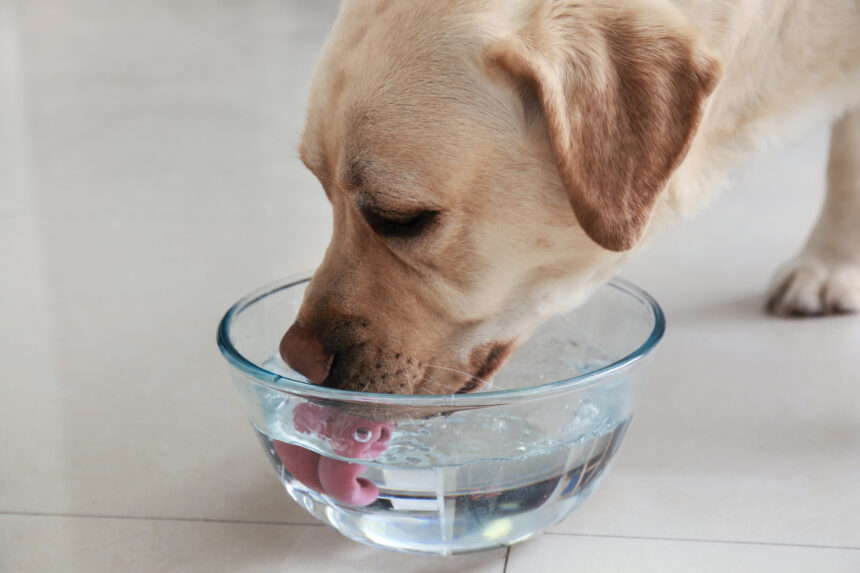Water is essential for life… without it, you would die – so would your dog. Your pup is about 75% water, and this vital liquid is necessary for regulating body temperature, keeping the skin elastic, lubricating joints, cushioning the nervous system, flushing wastes out of the body, helping with digestion, dissolving and transporting nutrients throughout the body and more.
Although we take access to fresh water for granted in the Western world, not all water sources – including tap water – are safe or beneficial for your canine companion, and some are even harmful. Read on to find out why.
Because alternative water options are plentiful – consider hydrating your furry friend with something other than tap water.
The unseen dangers of tap water
Do you drink the tap water in your home? If not, allowing your pet to drink it is not a good idea. Here are a few reasons for avoiding tap water whenever possible and a few healthy alternatives.
Disinfectants. Both chlorine and chloramine are acceptable methods of disinfecting drinking (tap) water, according to the U.S. Environmental Protection Agency ( EPA). High disinfectant levels can affect the taste and odor of water and may irritate your pup.
Ingesting water containing high levels of disinfectants can irritate your dog’s gastrointestinal tract, leading to inflammation. Symptoms include vomiting, diarrhea, and stomach pain. Your furry friend can also be allergic to chlorine or other chloramines and develop hives, itching, swelling, or even difficulty breathing.
If your pup inhales chlorinated water while swimming, fumes may irritate the respiratory trach’s mucous membranes, leading to coughing, wheezing, or difficulty breathing.
Fluoride. Most water contains some fluoride that is naturally occurring. Although controversial, many places add fluoride so that higher concentrations reduce tooth decay and promote good oral health.
If your canine companion ingests large amounts of fluoride, it can lead to gastrointestinal upset, such as vomiting, diarrhea, and nausea. Long-term exposure is scary and can lead to kidney dysfunction and damage.
Studies show that there are also potential severe risks of fluoride exposure, such as thyroid dysfunction, reproductive issues, osteosarcoma, and neurological disorders.
Pesticides and herbicides. Agricultural chemicals that control pests and weeds can make their way into water. Excessive and prolonged exposure to these toxins can disrupt the endocrine system and lead to cancer.
Heavy metals. Heavy metals can leach into tap water via household plumbing and service lines, cement plants, electronics manufacturers, mining operations, petroleum refineries, cement plants, etc.
Symptoms of heavy metal poisoning in pups include diarrhea with blood, arrhythmia, panting shock, lethargy, tremors, rapid heart rate, and vomiting.
Long-term exposure to heavy metals such as lead, mercury, copper, and cadmium can lead to several health problems for your pup, including kidney damage, cancer, and neurological issues.
Microorganisms. There are approximately 10 million bacteria inside the average glass of tap water. Although most of these bacteria won’t cause you or your canine friend any issues, some waterborne microorganisms can cause health issues, including;
- Hepatitis A
- E.coli
- Salmonella
- Giardia
- Campylobacter jeuni
- Cryptosporidium
Exposure to waterborne microorganisms often causes vomiting, diarrhea, lethargy, abdominal pain, and loss of appetite in dogs.
Microplastics. Microplastics are tiny plastic particles less than 5 millimeters in size, often resulting from the breakdown of larger plastic debris or products containing microbeads.
Tiny pieces of plastic can enter the water in several ways, including industrial runoff, plastic pollution in rivers and oceans, and even the breakdown of plastic pipes and packaging materials during water treatment.
According to a water survey, 94% of tap water in the United States is contaminated with foreign objects such as microplastics. This is a big problem not only for humans but also animals.
Although there are few specific studies on the impact of microplastics on dogs and cats, if other studies show toxic effects on fish and humans, it is a good sign that they are not healthy for our fur babies either.
PFAS (Per-and polyfluoroalkyl substances). These include synthetic chemicals that don’t break down, such as waxes, paints, food packaging, fire-fighting foam, cleaning products, etc. According to The National Institute of Environmental Health Sciences, 97% of Americans have a buildup of these carcinogenic substances in their bodies. Even low exposure to these dangerous chemicals in drinking water may cause serious health problems for humans and our pets.
Pharmaceuticals. Tap water samples have exposed a wide range of pharmaceuticals, including hormones, pain relievers, antibiotics, antidepressants, anticonvulsants, and more. Improper disposal of drugs, industrial runoff, and human and animal excretion are all pathways that drugs enter water sources. Sadly, these chemicals break down slowly and can accumulate over time. Because these chemicals are heavily diluted in tap water – minor exposure is not a huge concern, but little is known about the impact of chronic – low-level exposure in humans or pets.
Safe alternatives to tap water
To keep your furry friend safe and well-hydrated, consider these alternative forms of water, such as glass bottled spring water or filtered water.






